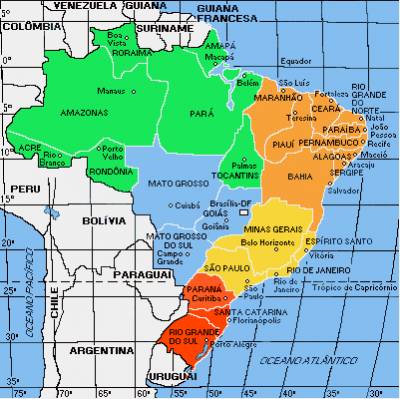
The States of the north east Brazil is a federal republic composed of 27 states grouped into five large regional administrations. The region of the north east of Brazil is made up of nine states (see map): Maranhao, Piauí, Ceará, Rio Grande do Norte, Paraiba, Pernambuco, Alagoas, Sergipe y Bahía, but the most interesting and privileged area of this region is the north east coast, specifically the area between the north of Fortaleza (the capital of the state of Ceará) and the south of Maceió (capital of the state of Alagoas).
Cities, beaches and nature
The principal cities of the north east coast are Fortaleza, Natal, Joao Pessoa, Olinda, Recife and Maceió, each with its own ambience, but all with spectacular marine esplanades and urban beaches bathed by warm waters. On the outskirts of these cities, both north and south, there are always kilometers and kilometers of splendid beaches, with incredibly varied and beautiful countryside, and close by there are stunning lakes and rivers, spectacular waterfalls, endless cliffs, enormous sand dunes (which can be visited by 'buggy'), coral reefs which form natural swimming pools, luxuriant vegetation, magnificently conserved ancient ruins, and paradisiacal islands and many other natural marvels.
Climate and other natural phenomena
Brazil is a huge country, therefore the climate differs from region to region. In some areas the heat can be asphyxiating (for example in Rio and Sao Paulo from December to March) and the humidity insufferable as in the Amazon region. Other areas have high amounts of rainfall and in the south of the country the temperatures can drop to only a few degrees above freezing from May to September. However, the climate of the north east coast is unbeatable almost year round: the sun always shines, and the strong rays are tempered by constant refreshing sea breezes. Tidal waves, hurricanes, earthquakes and other extreme natural forces are completely unknown phenomena on the north east coast of Brazil.
The journey from Europe
When thinking about the journey from Europe, once again the size of Brazil has to be taken into account. It is not the same travelling to the Amazon or the southern states of the country such as Santa Catarina or Rio Grande do Sul, or even Rio or Sao Paulo, as to the north east coast of Brazil which is thousands of miles closer to Europe (in fact the closest point to Europe on the American continent is located between Natal and Recife). This means shorter and easier journeys: only a 7 hour flight compared with 10-11 hours, or even more, which would be entailed in a trip to other areas more south, north or west in Brazil.
Distances and road transport
Also, compared with the large distances between cities in other areas of Brazil which mean that the only viable means of transport is by air, on the north east coast the cities are a comfortable drive apart, just three or four hours by car or coach. There are coaches called 'leitos', which apart from air conditioning and other comforts, have business class airline style seats which allow total relaxation whilst enjoying the magnificent countryside, or even a pleasant sleep with a blanket and pillow.
Safety and peace of mind
The north east coast is as a whole extremely peaceful and the level of security is incomparably superior to cities such as Sao Paolo or Rio de Janeiro. Apart from certain marginal or extremely poor areas, the foreign visitor is no more at risk in the villages and cities of the north east coast of Brazil than in Paris, Turkey or New York. There are many areas in which a car would not be stolen, even with the doors left unlocked and where a bag would not disappear from the beach, or if left in a bar, shop or restaurant.
To ensure that you are not a victim of crime on the north east coast of Brazil, it is enough to use your common sense and observe the simple security precautions, which are exactly the same as those which a foreign visitor should observe worldwide.
Friendly, open and spontaneous people
Finally, to finish a chapter which would be interminable, it should be underlined that the splendors of nature, the absence of mass tourism and the benign climate of the north east coast is reflected in the character of the people, who are open and friendly, calm, cheerful and spontaneous, which is a true blessing for everybody and especially for the foreign visitor who comes to one of the most beautiful, most secure, most inexpensive, most interesting, most cheerful and most pleasing places in Brazil: the north east coast.
|